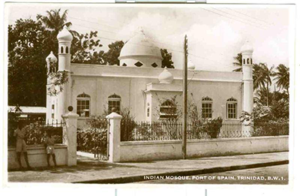By Angelo Bissessarsingh
 The contribution of our Muslim brothers and sisters in the field of art, music, education, medicine, business and politics cannot be overstated. Their contribution to the ever changing landscape of Trinidad &Tobago is immeasurable. From the 1800s to the present day, they co-exist in peace with other religions and their economic impact continues to strengthen the foundations they have built since they first came. We salute them for their valuable contributions and thank them for it.
The contribution of our Muslim brothers and sisters in the field of art, music, education, medicine, business and politics cannot be overstated. Their contribution to the ever changing landscape of Trinidad &Tobago is immeasurable. From the 1800s to the present day, they co-exist in peace with other religions and their economic impact continues to strengthen the foundations they have built since they first came. We salute them for their valuable contributions and thank them for it.
There is considerable controversy over the name Fath Al Razack and Fatel Rozack but wherever the debris of this controversy will eventually settle and its interpretation of its links to Islam, whether by name or by ownership, points to the role of Islam and the very first East Indian Muslims that landed here in 1845.
Some historical scholars and researchers are quick to point that some of the enslaved Africans brought to the West Indies were also Muslims, having been exposed to the great Islamic incursions many years earlier in North and coastal regions of Africa. Their religious practice was, however, frowned upon by the colonisers. History records that the second group arrived in 1816 as a small proportion of the Colonial Marine Corps of African Descent. They had been recruited in 1815 in Georgia. Most of them settled in Fifth and Sixth Company within the company villages near Princes Town. These were followed by African Muslims from the disbanded West India Regiments and settled between 1817 and 1825 in Manzanilla on the east coast. Many African Muslims were also brought to Trinidad by the interception of the British Royal Navy of slave ships that were in violation of the Slave Trade Acts of 1824. The British, however, were a bit more tolerant and respected the cultural and religious differences between Hindus and Muslims. They were kept in separate compartments on board the ships and allowed to cook their meals separately.
The majority of the East Indian muslims who came were Hanafi Muslims. However, there were some Shi’ites also. They did not identify with their new homeland and their religion and culture gave them a sense of security. It was this sense that they developed very close bonds. They also had the bitter experience of more men than women, especially Muslim women, so there was a greater urgency to return to India. There was an absence of any real family life.
There was no great connection to any champion of the Muslims from mother India. Islam, however, has no scarcity of intellectual minds among its believers and it was men like Syed Abdul Aziz, a religious scholar and educator who became a lion for the cause of Muslims, challenging the colonial authorities for a space within the Caribbean space not only for the Moslems but for East Indians on the whole. It was in this landscape that the first mosque was built in Iere Village, Princes Town. All over the country a series of mosques and their jamaats were established, most noteworthy, one at Queen Street, Port-of-Spain. In 1926, the TIA was incorporated by an Act of Parliament.
Source: T & T Guardian


